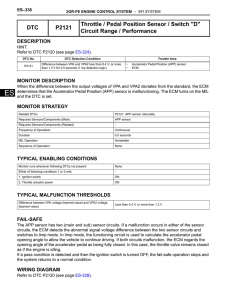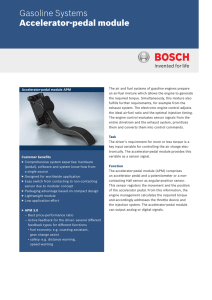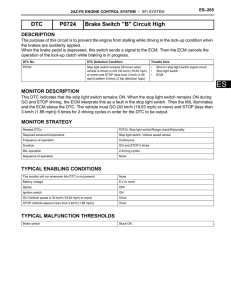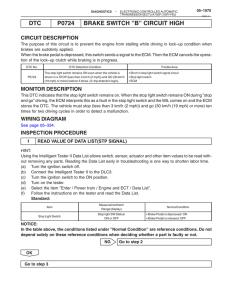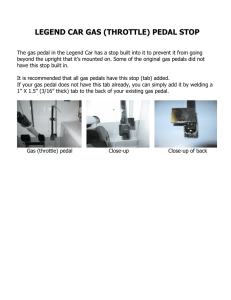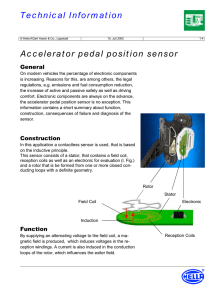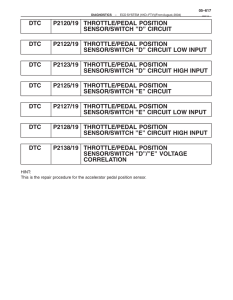DTC P2121 Throttle / Pedal Position Sensor / Switch "D" Circuit
advertisement
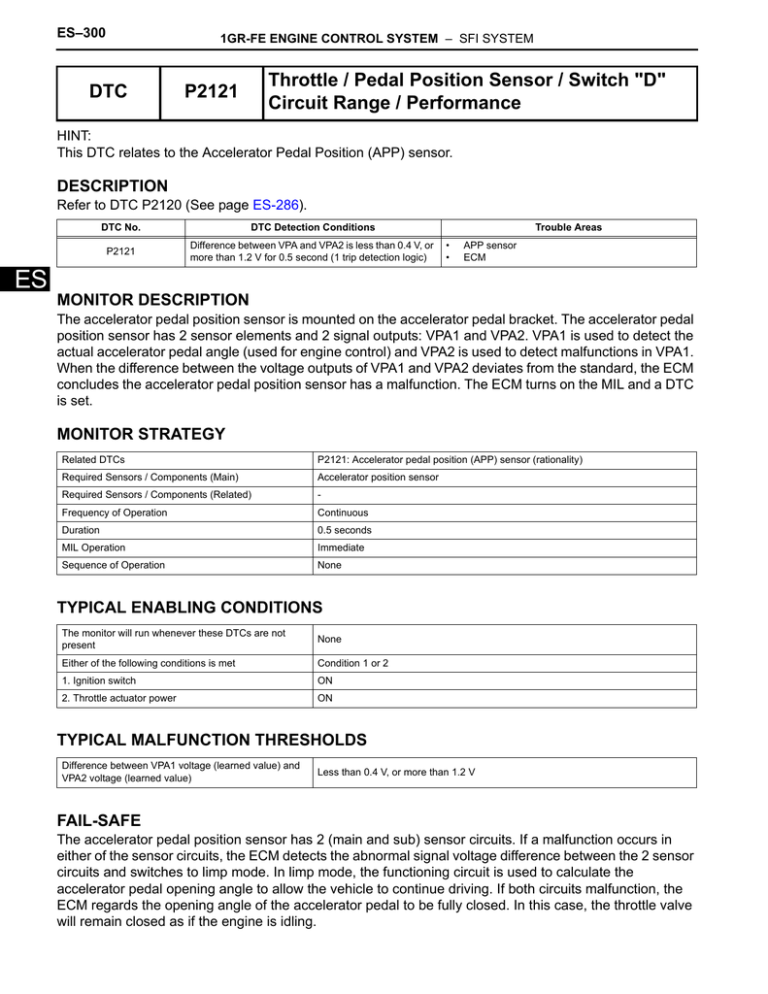
ES–300 1GR-FE ENGINE CONTROL SYSTEM – SFI SYSTEM DTC Throttle / Pedal Position Sensor / Switch "D" Circuit Range / Performance P2121 HINT: This DTC relates to the Accelerator Pedal Position (APP) sensor. DESCRIPTION Refer to DTC P2120 (See page ES-286). DTC No. DTC Detection Conditions P2121 Difference between VPA and VPA2 is less than 0.4 V, or more than 1.2 V for 0.5 second (1 trip detection logic) Trouble Areas • • APP sensor ECM ES MONITOR DESCRIPTION The accelerator pedal position sensor is mounted on the accelerator pedal bracket. The accelerator pedal position sensor has 2 sensor elements and 2 signal outputs: VPA1 and VPA2. VPA1 is used to detect the actual accelerator pedal angle (used for engine control) and VPA2 is used to detect malfunctions in VPA1. When the difference between the voltage outputs of VPA1 and VPA2 deviates from the standard, the ECM concludes the accelerator pedal position sensor has a malfunction. The ECM turns on the MIL and a DTC is set. MONITOR STRATEGY Related DTCs P2121: Accelerator pedal position (APP) sensor (rationality) Required Sensors / Components (Main) Accelerator position sensor Required Sensors / Components (Related) - Frequency of Operation Continuous Duration 0.5 seconds MIL Operation Immediate Sequence of Operation None TYPICAL ENABLING CONDITIONS The monitor will run whenever these DTCs are not present None Either of the following conditions is met Condition 1 or 2 1. Ignition switch ON 2. Throttle actuator power ON TYPICAL MALFUNCTION THRESHOLDS Difference between VPA1 voltage (learned value) and VPA2 voltage (learned value) Less than 0.4 V, or more than 1.2 V FAIL-SAFE The accelerator pedal position sensor has 2 (main and sub) sensor circuits. If a malfunction occurs in either of the sensor circuits, the ECM detects the abnormal signal voltage difference between the 2 sensor circuits and switches to limp mode. In limp mode, the functioning circuit is used to calculate the accelerator pedal opening angle to allow the vehicle to continue driving. If both circuits malfunction, the ECM regards the opening angle of the accelerator pedal to be fully closed. In this case, the throttle valve will remain closed as if the engine is idling. ES–301 1GR-FE ENGINE CONTROL SYSTEM – SFI SYSTEM If a "pass" condition is detected and then the ignition switch is turned off, the fail-safe operation will stop and the system returns to a normal condition. WIRING DIAGRAM Refer to DTC P2120 (See page ES-290). INSPECTION PROCEDURE HINT: Read freeze frame data using the intelligent tester. The ECM records vehicle and driving condition information as freeze frame data the moment a DTC is stored. When troubleshooting, freeze frame data can be helpful in determining whether the vehicle was running or stopped, whether the engine was warmed up or not, whether the air/fuel ratio was lean or rich, as well as other data recorded at the time of a malfunction. 1 READ VALUE OF INTELLIGENT TESTER (ACCEL POS #1 AND ACCEL POS #2) (a) Connect the intelligent tester to the DLC3. (b) Turn the ignition switch on and turn the tester on. (c) Select the following menu items: DIAGNOSIS / ENHANCED OBD II / DATA LIST / ALL / ACCEL POS #1 and ACCEL POS #2. (d) Read the values displayed on the tester. Standard voltage Depressed Released Accelerator Pedal Operations ACCEL POS #1 (AP#1) ACCEL POS #2 (AP#2) Released 0.5 to 1.1 V 1.2 to 2.0 V Depressed 2.6 to 4.5 V 3.4 to 5.0 V FI07052E14 OK NG Go to step 4 ES ES–302 2 1GR-FE ENGINE CONTROL SYSTEM – SFI SYSTEM CHECK HARNESS AND CONNECTOR (ACCELERATOR PEDAL POSITION SENSOR ECM) Wire Harness Side: VPA2 VCP2 EP1 VPA1 1 ES A24 VCP1 EP2 2 3 4 5 (a) Disconnect the A24 Accelerator Pedal Position (APP) sensor connector. (b) Disconnect the E8 ECM connector. (c) Measure the resistance. Standard resistance (Check for open) 6 Accelerator Pedal Position Sensor Connector ECM: EPA VPA2 E8 VPA Tester Connections Specified Conditions VPA1 (A24-6) - VPA (E8-18) Below 1 Ω EP1 (A24-5) - EPA (E8-20) Below 1 Ω VCP1(A24-4) - VCPA (E8-26) Below 1 Ω VPA2 (A24-3) - VPA2 (E8-19) Below 1 Ω EP2 (A24-2) - EPA2 (E8-21) Below 1 Ω VCP2 (A24-1) - VCP2 (E8-27) Below 1 Ω Standard resistance (Check for short) Tester Connections EPA2 VCP2 VCPA Specified Conditions VPA1 (A24-6) or VPA (E8-18) - Body ground 10 kΩ or higher EP1 (A24-5) or EPA (A24E8-20) - Body ground 10 kΩ or higher VCP1 (A24-4) or VCPA (E8-26) - Body ground 10 kΩ or higher VPA2 (A24-3) or VPA2 (E8-19) - Body ground 10 kΩ or higher A114633E04 EP2 (A24-2) or EPA2 (E84-21) - Body ground 10 kΩ or higher VCP2 (A24-1) or VCP2 (E8-27) - Body ground 10 kΩ or higher (d) Reconnect the APP sensor connector. (e) Reconnect the ECM connector. NG REPAIR OR REPLACE HARNESS OR CONNECTOR OK 3 REPLACE ACCELERATOR PEDAL ROD ASSEMBLY (a) Replace the accelerator pedal rod assembly (See page ES-436). NEXT 4 CHECK WHETHER DTC OUTPUT RECURS (ACCELERATOR PEDAL POSITION SENSOR DTCS) (a) (b) (c) (d) (e) (f) Connect the intelligent tester to the DLC3. Turn the ignition switch on and turn the tester on. Clear DTCs (See page ES-31). Start the engine. Allow the engine to idle for 15 seconds. Select the following menu items on the tester: DIAGNOSIS / ENHANCED OBD II / DTC INFO / CURRENT CODES. (g) Read DTCs. ES–303 1GR-FE ENGINE CONTROL SYSTEM – SFI SYSTEM Result Display (DTC Output) Proceed to P2121 A No output B B SYSTEM OK A REPLACE ECM ES
